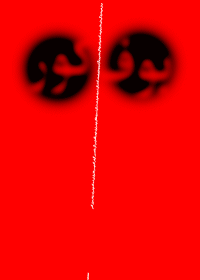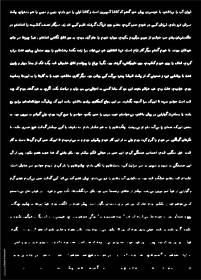
Amirali Ghasemi

Majid Abbasi

Ali Khorshidpour

Farzad Adibi
This exhibition was organized for the 100th birth anniversary of Sadeq Hedayat (1903-1951), the foremost Iranian avant-garde and contemporary writer. His best known work, The Blind Owl (in Iranian Bouf-e kour) gave the show it's title.
The graphic designers were supposed to create a work with the Persian letters based on the name of the writer or one of his books. The exhibition was held with sixty three different works from forty four graphic designers in Seyhoun Gallery, a forty-year-old and well-known gallery in Tehran in January 2003. This was a good opportunity for the Iranian graphic designers to show their works in a group. The catalog of the exhibition is available in both Persian and English.
If someone, whether he can read or not, sees a good piece of writing, he likes to enjoy the sight of it.
The recorded calligraphy in the history of Iran reveals a lot about the importance of this art among Iranians. Iranian civilization dates back to seven or eight thousand years ago and now there are many signs left from the Iranian art and culture. But calligraphy became important about a thousand years ago and every Iranian used to learn its skills.
This art improved more in Iran after Islam and mixed with the Muslims' art. There were eight known styles of writing then: Koofi, Mohaghegh, Sols, Naskh, Divani, Rogheh, Nastaligh and Shekasteh which were all used in calligraphy. But nowadays, Iranian and Arabic designers have made other fonts based on those main eight. The Arabic alphabet has twenty eight letters but four letters more have been added to Farsi and made it thirty two letters.
The modern typography which can mainly be seen in European and American works, was transformed by the designers to have its own rules. But in Iran as well as other countries that have a sort of profound traditional art, calligraphy is still one of the highest forms of art.
Persian typography that is developed from the Arabic typography unlike any other Latin origin styles is written from right to left. But like the Latin style, the letters move horizontally. Each letter has different forms and when they stick to each other they form a word. Each letter has a first, middle, last and also an individual form, therefore Persian letters are designed individually in the above-mentioned forms.
When the printing industry came to Iran and newspapers and ads were started, publishing books began to appear by the leaden letters and helped the very first forms of the Persian typography. Later the first efforts were made for the typography by arranging these letters because before that calligraphers had the last word!
But the modern typography owes to the Iranian graphic designers' efforts in the recent four decades. Morteza Momayez, Sadegh Barirani, Ghobad Shiva and Farshid Mesghali have created some very prominent works in this field. Some other artists such as Reza Mafi, Faramarz Pilaram, Mohammad Ehsai and Hossein Zenderoodi created their paintings by mixing them with Persian letters where typography is very noticeable.
There were also some other efforts in designing typography by other graphic designers and the styles are now used. If we want to separate the calligraphy (composition of the letters with traditional rules) from the typography (composition of the letters with modern rules), we should search in the recent four decades and all the efforts made by the designers as well as the modern printing.
 Majid Abbasi is an art director and graphic designer in Tehran (IR) and has recently curated exhibitions there on
Jan Lenica and Ralph Schraivogel. He is a founding member of the group "The 5th Color". His poster for an exhibition of
photographs of Sadeq Hedayat has been shown in Tehran, Warsaw, Brno, Echirolles, Cracow and on the
Poster Page, of course.
Majid Abbasi is an art director and graphic designer in Tehran (IR) and has recently curated exhibitions there on
Jan Lenica and Ralph Schraivogel. He is a founding member of the group "The 5th Color". His poster for an exhibition of
photographs of Sadeq Hedayat has been shown in Tehran, Warsaw, Brno, Echirolles, Cracow and on the
Poster Page, of course.

Ali Korshidpour

Saed Meshki

Pedram Harby

Firouz Shafeie